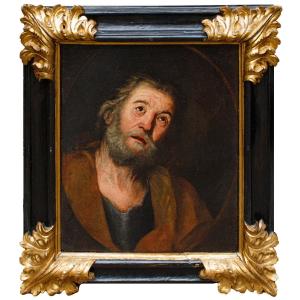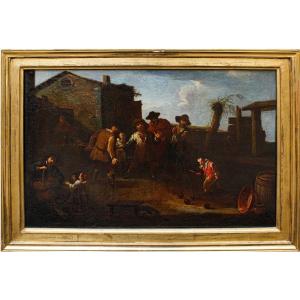XVIII century
Portraits of the Roman emperors Sergio Galba and Vespasiano
(2) Oil on canvas, cm 56.5 x 48
With frame cm 67 x 58
The construction of the two paintings in question comes from the lost cycle of the Roman Emperors realized by Titian for Federico Gonzaga di Mantova between 1536 and 1539. The twelve portraits of emperors, whose deeds were described by Quiet Caius Svetonius, are mentioned in 1550 by Vasari in the Torrentinian edition of the Vines, which places them in the antechamber of the Stanza di Troia in the Ducal Palace of Mantua. Tiziano executed the 11 paintings between 1537 and 1538. In 1628 the paintings were bought by Charles I, who took them to England, then transferred them to Spain, where they were destroyed in the fire of the Alcazar in 1734. They are remembered in the engravings of Egidio Sadeler and in the drawings of Jacopo Strada. The extraordinary spread of these iconographies, however, is due to Bernardino Campi, a painter from Cremona particularly prolific and appreciated by the Lombard nobility in the second half of the sixteenth century, when in 1561 Francesco Ferdinando d'Avalos during a stay at the court of Mantua asked the painter to make copies drawn today lost of the eleven Cesars of Titian adding by his hand the portrait of Domiziano. On his return to Milan, Campi produced the first of many series of twelve paintings in Tiziano’s beautiful and robust manner. As an example, in the ninth decade the artist received from Vespasiano Gonzaga the order to create a series of twelve paintings on canvas depicting as many Roman emperors to be placed in the Ducal Palace of Sabbioneta.The two emperors represented are Galba and Vespasian: the first reigned for a limited period, from 68 A.D. to 69 A.D.: successor of Nero, Galba was violently murdered in a conspiracy by the rival and future emperor Otto. The second, Vespasian, was the first emperor of the Flavian dynasty and obtained the kingdom at the end of 69 AD: he descended from a modest family of the Italic equestrian class (his father was tax collector in Sabina). He had made himself, rising up the ranks of the army on his merits. In 69 A.D., with the lex de imperio Vespasiani, he had all the powers of which his predecessors had enjoyed assigned to him en bloc. He declared without any ambiguity that his sons Titus and Domitian would succeed him. In this way he ended the idea of the prince as "first among peers". In fact, it swept away the fiction of the republic, which now only formally survived. It was with Vespasian that the principality began to be called an empire. He was aware that it was necessary to restore consensus around the figure of the prince and give stability back to the empire. It then implemented a policy aimed at peace and internal security. He realigned the finances, establishing that any new expenditure should have adequate coverage in the public budget. He gave up the court glories. He did not give up undertaking important and useful public works, including the famous amphitheatre Flavio, better known as Colosseum. To bring the inhabitants of the provinces closer to Rome, Vespasian extended the right of citizenship, favoring a massive introduction of provincial elements among imperial officials and in the senatorial aristocracy. In the 10 years of his reign, Vespasian was able to guarantee, after a long period of instability, peace and prosperity at the economic level in Rome and the provinces.








































 Le Magazine de PROANTIC
Le Magazine de PROANTIC TRÉSORS Magazine
TRÉSORS Magazine Rivista Artiquariato
Rivista Artiquariato